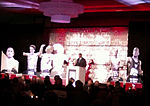Hilltop Park

Hilltop Park was the nickname of a baseball park that stood in the Washington Heights neighborhood of New York City. It was the home of the New York Yankees of Major League Baseball from 1903 to 1912, when they were known as the "Highlanders". It was also the temporary home of the New York Giants during a two-month period in 1911 while the Polo Grounds was being rebuilt after a fire. The ballpark's formal name, as painted on its exterior walls, was American League Park. Because the park was located on top of a ridge of Manhattan Island, it came to be known as Hilltop Park, and its team was most often called the New York Highlanders (as well as the Americans and the Yankees). This "Highland" connection contrasted with their intra-city rivals, the Giants, whose Polo Grounds was just a few blocks away, in the bottomland under Coogan's Bluff. Hilltop Park sat on the block bounded by Broadway, 165th Street, Fort Washington Avenue, and 168th Street. The structure consisted of a covered grandstand stretching from first base to third base and uncovered bleacher sections down the right and left field lines. Originally built in just six weeks, the park sat 16,000, with standing room for an additional 10,000 or so. The bleachers were covered in 1911, and also bleachers to seat an additional 5,000 fans were built in 1911 (partially to accommodate Giants fans, who were temporary tenants after the Polo Grounds fire) in center field. The field was initially huge by modern standards — 365 ft (111 m) to left field, 542 ft (165 m) to center field and 400 ft (120 m) to right field. An inner fence was soon constructed to create more realistic action. Both the park and the nickname "Highlanders" were abandoned when the American Leaguers left, at the beginning of the 1913 season, to rent the Polo Grounds from the Giants. The Polo Grounds had a far larger seating capacity, and by that time was made of concrete due to the 1911 fire. Hilltop Park was demolished in 1914.
Excerpt from the Wikipedia article Hilltop Park (License: CC BY-SA 3.0, Authors, Images).Hilltop Park
West 168th Street, New York Manhattan
Geographical coordinates (GPS) Address Phone number Website Nearby Places Show on map
Geographical coordinates (GPS)
| Latitude | Longitude |
|---|---|
| N 40.840555555556 ° | E -73.942222222222 ° |
Address
Columbia University Irving Medical Center
West 168th Street 630
10031 New York, Manhattan
New York, United States
Open on Google Maps









